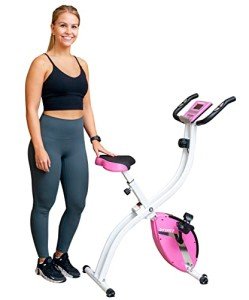Stationary Bike Exercise's History Of Stationary Bike Exercise In 10 Milestones

The Stationary Bike Exerciser: Your Comprehensive Guide to Effective Indoor Cycling
In the realm of fitness, stationary bike exercisers have actually risen in appeal, interesting both skilled professional athletes and casual professionals alike. Created to duplicate outside cycling, these devices provide a convenient and effective method to enhance cardiovascular health, develop strength, and promote overall well-being. This short article explores the advantages, types, functions, and best practices related to stationary bike exercisers, offering a thorough understanding for anybody interested in integrating this tool into their fitness regimen.
Comprehending the Stationary Bike Exerciser
A stationary bike exerciser, frequently referred to as a stationary bicycle, is a piece of gym equipment designed for indoor cycling exercises. Unlike outdoor bicycles, these bikes are particularly engineered to provide an efficient workout without the requirement to endeavor outside, making them perfect for numerous settings, consisting of homes, health clubs, and rehab centers.
Benefits of Using a Stationary Bike
- Cardiovascular Health: Regular cycling reinforces the heart, lungs, and circulatory system, decreasing the risk of heart problem and enhancing total endurance.
- Weight Management: Stationary cycling burns significant calories, making it an effective tool for weight-loss and management. Depending on strength and duration, a person can burn between 300-700 calories per hour.
- Joint-Friendly Exercise: Cycling is a low-impact workout, making it an exceptional choice for those with joint issues or those recovering from injuries. It offers a method to get cardiovascular training without putting unnecessary tension on the knees and hips.
- Customization and Versatility: Many stationary bicycles included adjustable resistance levels, seat heights, and handlebars, enabling users to tailor their workout experience to their fitness levels and preferences.
- Convenience: The ability to exercise inside your home means that users can keep their fitness routines no matter weather condition conditions or time restraints.
Kinds Of Stationary Bike Exercisers
When exploring stationary bicycles, prospective users will come across a range of options matched to various fitness levels and preferences. The main types consist of:
- Upright Bikes: These look like traditional bicycles, where the user beings in an upright position. They engage a broad variety of muscles and are great for those seeking a high-intensity workout.
- Recumbent Bikes: Featuring a reclined seat with back support, recumbent bikes provide a comfy cycling position. They are ideal for individuals with back issues or those seeking a gentler workout.
- Indoor Cycling Bikes: Also called spin bikes, these bikes simulate the feel of road cycling. They are designed for high-intensity period training (HIIT) and group fitness classes.
- Dual-Action Bikes: These bikes have moving handlebars matched with pedals, enabling both upper and lower body workouts, enhancing calorie burn and muscle engagement.
Key Features to Consider
When picking a stationary bike exerciser, it's vital to evaluate various features that deal with specific requirements:
Resistance Type:
- Magnetic Resistance: Offers a smooth and quiet cycling experience, with quickly adjustable resistance levels.
- Friction Resistance: Common in spin bikes, this type uses a pad to develop resistance; however, it can be noisier and needs more maintenance.
Convenience:
- Look for adjustable seats and handlebars to guarantee a proper fit. Also, take note of seat comfort, as extended exercises can be laborious on an uncomfortable seat.
Screen and Tracking:
- Many bikes come geared up with digital displays that track metrics like time, range, speed, calories burned, and heart rate. Some advanced designs even link to apps for enhanced tracking and interaction.
Portability:
- Consider the weight of the bike and whether it has transport wheels for easy relocation if needed.
Budget:
- Prices for stationary bicycles vary commonly, from basic designs to high-end versions with innovative features. Establish a budget that fits individual requirements and explore choices within that variety.
Effective Practices for Using a Stationary Bike
To optimize the advantages of a stationary bicycle exerciser, think about the following practices:
- Set Realistic Goals: Setting specific, quantifiable, possible, pertinent, and time-bound (SMART) objectives assists track progress and preserve motivation.
- Warm-Up and Cool Down: Prior to diving into a workout, a warm-up of 5-10 minutes allows muscles to prepare, while cooling off post-exercise help in healing.
- Include Variety: Mix up your exercises by varying the resistance levels, including periods, or joining virtual cycling classes to keep your regular fresh and engaging.
- Stay Hydrated: Always keep water within reach, particularly during longer exercises where fluid loss can become substantial.
- Posture Matters: Maintain an erect posture, with shoulders back and elbows somewhat bent, to prevent straining your back and neck.
Frequently Asked Questions About Stationary Bike Exercisers
Q: How long should I ride a stationary bike to see results?A: For significant benefits, go for a minimum of 150 minutes of moderate-intensity cycling or 75 minutes of vigorous-intensity cycling weekly. Slowly increase duration and intensity for continued enhancements. Q: Is it safe to use a stationary bike every
day? Fitness Bicycle For Sale : Yes, using a stationary bicycle daily can be safe, provided you listen to your body and enable day of rest as needed to promote healing and prevent overuse injuries. Q: How do I maintain my stationary bike?A: Regularly examine and tighten up bolts, tidy the bike frame, and keep track of the resistance system. If utilizing a belt-driven bike, ensure the belt remains in great condition and correctly changed. In conclusion, stationary bike exercisers serve as a versatile and effective
instrument in the quest for enhanced fitness. By comprehending the advantages, types, essential features, and best practices associated with them, people can make educated choices on how to successfully integrate cycling into their exercise regimens. Whether for cardiovascular health, muscle tone, or weight management, these devices hold the possible to change indoor workouts into effective fitness sessions.

